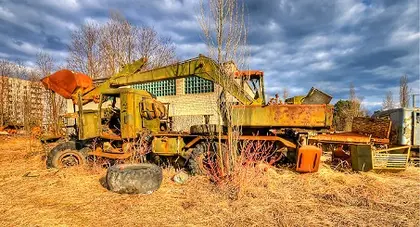A police car in the United States is likely to have roughly three years or 60,000 miles of service before it’s sold, probably at auction. The police cars in Ukraine at the Chornobyl police station have an entirely different life cycle. The Russians have disrupted this cycle and, in the process, created a global health risk.
Life cycle of a Chornobyl police car
JOIN US ON TELEGRAM
Follow our coverage of the war on the @Kyivpost_official.
Normally a Chornobyl police car would last seven to ten years and then end up in Chornobyl’s radioactive scrapyard, safely away from the general population. When the Russians invaded, they disrupted that cycle.
Pavel Maraev, a volunteer with the Kyiv Regional Police, told me: “Any police car in the world probably would have a life story to ‘tell’ if it could talk, from the moment it joins the force until it ‘peacefully’ retires to be resold or reused in the aftermarket. Chances are, it will continue its service to people for many years after leaving the Force.”
“The Chornobyl Police cars are different,” he said. “They have a one-way ticket when they enter the Chornobyl Exclusion Zone. Police vehicles never leave the Zone from the day when they enter.”
During those 8 years while the vehicles are in service, radiation left over from the Chornobyl disaster 38 years ago takes its toll. “The cars will accumulate enough radiation that they have to be decommissioned and taken to the ‘equipment graveyard’ along with other trucks, fire engines and other police cars that served in the Exclusion Zone,” Maraev said.

Zelensky: Russia’s Next Target is Ukraine’s Nuclear Power Stations
The vehicles will stay there for the next 100 years or until radiation is no longer a threat.
Chornobyl’s radioactive scrapyard
The “equipment graveyard,” Maraev says, “is the saddest open-air museum in the world.”
This “museum” contains all the equipment that served the workers at Chornobyl since the day Chornobyl blew up. “A lot of the people who used those cars are now gone because of the radiation,” he said. “The metal there will outlive their owners for many years to come, serving as a silent proof that metal outlives the living.”
Ideally, no visitors will come to this silent graveyard. The Zone is closed, and the cars are supposed to stay there, slowly rusting away, perfectly functional most of the time and yet deadly to anything alive.
Poachers spread radiation and death
One of the major responsibilities of the Chornobyl police is to keep poachers from raiding this radioactive scrapyard. The radiation coming from Chornobyl’s scrapyard can cause radiation sickness and death.
The deadly problem is when a scrap metal poacher takes highly irradiated metal and sells it, the metal can find its way into industrial processes throughout the world. Scrap metal could end up in a car factory, wall sockets, or any of thousands of other uses.
Even a small amount of the irradiated scrap metal can contaminate vast amounts of material and cause serious illness.
Radiation can destroy human tissue. At worst, radiation can strip a person’s chromosomes and wreck their DNA, causing tumors, tooth loss, blindness, organ failure, and unremitting pain.
With almost 1,000 square miles to police in the Exclusion Area, the Chornobyl Police have their hands full, trying to keep the poachers out. However, with the Russia-friendly border country of Belarus just across the Pripyat River from Chornobyl, and an active war going on, giving the job their full attention isn’t easy.
Russia’s invasion has magnified a global health threat by interfering with the containment of radioactive materials in Chornobyl’s Exclusion Zone. Russia’s act of aggression increased the likelihood of irradiated scrap metal seeping into global supply chains, posing an insidious and far-reaching danger that that can last for generations.
You can also highlight the text and press Ctrl + Enter






